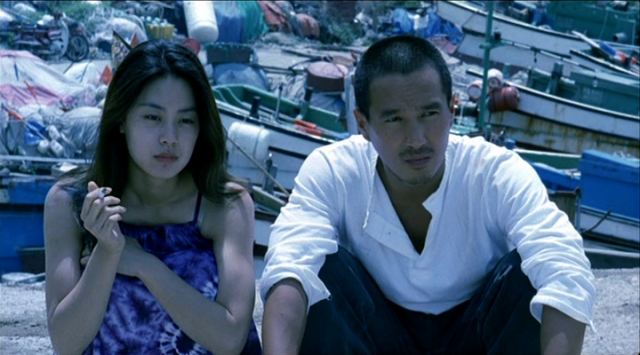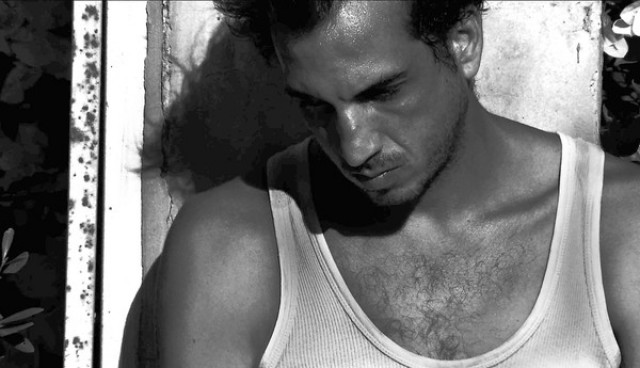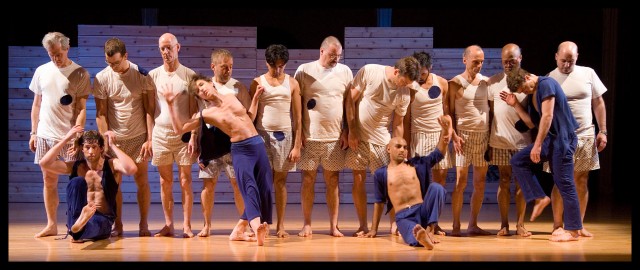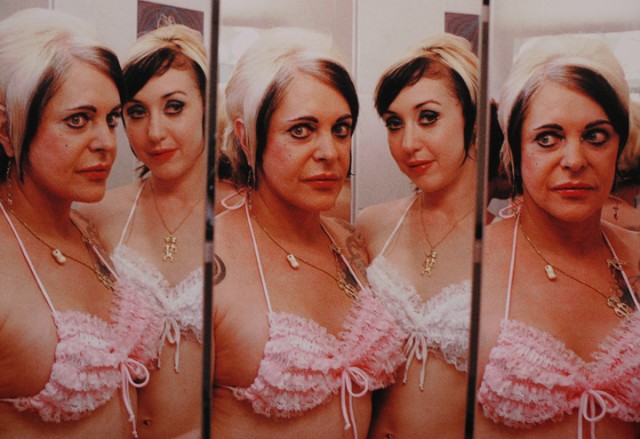
TIME kicks off a trio of films by Korean director Kim Ki-duk at Japan Society
TIME (SHI GAN) (Kim Ki-duk, 2006)
Japan Society
333 East 47th St. at First Ave.
Saturday, March 10, $12, 3:00
Series runs through March 18
212-715-1258
www.japansociety.org
www.timethemovie.net
 The excellent Japan Society series “Love Will Tear Us Apart,” which consists of Japanese and Korean films dealing with erotic obsession, continues on March 10 with three works by Korean auteur Kim Ki-duk, beginning at 3:00 with Time. After two years together, See-hee (Seong Hyeon-ah) thinks that her boyfriend, Ji-woo (Ha Jung-woo), has lost interest in her. She goes crazy jealous whenever he even so much as takes a peek at another woman, embarrassing him in public time and time again. But when she suddenly disappears, he soon realizes that he can’t live without her. And he won’t necessarily have to; See-hee has taken off to have a plastic surgeon (Kim Sung-min) completely change her face so she can make Ji-woo fall in love with her (now played by Park Ji-yun) all over again, even if he doesn’t know who she really is. But it is a lot harder to change one’s inner psyche than outward physical appearance. Kim, who has made such unusual and compelling films as 3-Iron, The Bow, and Spring, Summer, Fall, Winter . . . and Spring, has crafted yet another fascinating drama that challenges the audience with its unique and unexpected twists and turns, asking intriguing questions rather than doling out simplistic answers. Kim shows the passage of time as a natural enemy to love and romance — but one that can be overcome. “Time travels in divers paces with divers persons,” Shakespeare wrote in As You Like It. And so it does in this difficult yet memorable film.
The excellent Japan Society series “Love Will Tear Us Apart,” which consists of Japanese and Korean films dealing with erotic obsession, continues on March 10 with three works by Korean auteur Kim Ki-duk, beginning at 3:00 with Time. After two years together, See-hee (Seong Hyeon-ah) thinks that her boyfriend, Ji-woo (Ha Jung-woo), has lost interest in her. She goes crazy jealous whenever he even so much as takes a peek at another woman, embarrassing him in public time and time again. But when she suddenly disappears, he soon realizes that he can’t live without her. And he won’t necessarily have to; See-hee has taken off to have a plastic surgeon (Kim Sung-min) completely change her face so she can make Ji-woo fall in love with her (now played by Park Ji-yun) all over again, even if he doesn’t know who she really is. But it is a lot harder to change one’s inner psyche than outward physical appearance. Kim, who has made such unusual and compelling films as 3-Iron, The Bow, and Spring, Summer, Fall, Winter . . . and Spring, has crafted yet another fascinating drama that challenges the audience with its unique and unexpected twists and turns, asking intriguing questions rather than doling out simplistic answers. Kim shows the passage of time as a natural enemy to love and romance — but one that can be overcome. “Time travels in divers paces with divers persons,” Shakespeare wrote in As You Like It. And so it does in this difficult yet memorable film.

Kim Ki-duk’s BAD GUY is just plain bad
BAD GUY (NABBEUN NAMJA) (Kim Ki-duk, 2001)
Japan Society
333 East 47th St. at First Ave.
Saturday, March 10, $12, 5:00
Series runs through March 18
212-715-1258
www.japansociety.org
www.badguythemovie.net
 Kim Ki-duk has made a number of excellent films, but Bad Guy is not one of them. Instead, it’s a preposterous, painfully puerile, and deeply misogynistic movie that is insulting from start to finish. Although it’s only a hundred minutes long, it feels like a thousand. Won Seo stars as Sun-hwa, a college girl who gets conned by Han-ki (Cho Je-hyun) into becoming a prostitute to pay off a false debt. He watches her transformation through a two-way mirror while one of his henchmen, Myung-soo (Choi Duk-moon), thinks he has fallen in love with her himself. Lots of sex and violence ensue, most of which makes no sense and is as unbelievable as the premise. The evening concludes at 7:30 with Kim’s 2008 Dream, a tale in which two people’s dreams intersect.
Kim Ki-duk has made a number of excellent films, but Bad Guy is not one of them. Instead, it’s a preposterous, painfully puerile, and deeply misogynistic movie that is insulting from start to finish. Although it’s only a hundred minutes long, it feels like a thousand. Won Seo stars as Sun-hwa, a college girl who gets conned by Han-ki (Cho Je-hyun) into becoming a prostitute to pay off a false debt. He watches her transformation through a two-way mirror while one of his henchmen, Myung-soo (Choi Duk-moon), thinks he has fallen in love with her himself. Lots of sex and violence ensue, most of which makes no sense and is as unbelievable as the premise. The evening concludes at 7:30 with Kim’s 2008 Dream, a tale in which two people’s dreams intersect.

 “For me, cinema is sorcery, a creative way to interact with the world in order to rearrange perception and expand consciousness — both the viewer’s and my own,” says master filmmaker Nina Menkes. A citizen of Israel, Germany, and the United States, Menkes has made only six feature-length films and three shorts over the course of thirty years but has established an international reputation that deserves to be more widespread in America. On the occasion of the U.S. theatrical release of her latest film, Dissolution, Anthology Film Archives is holding a retrospective of Menkes’s career, following a festival held last month at her alma mater, UCLA. Shot in an Arab section of Tel Aviv and loosely based on Dostoyevsky’s Crime and Punishment, Dissolution is an intense psychological drama seething with an inner violence that is ready to explode at any moment. Didi Fire, who cowrote and coedited the film with Menkes, stars as a deeply troubled Israeli man desperate for money. The film opens with Fire gently nudging a snail with his foot, the imminent threat of his stomping on it readily apparent. Soon he is furiously sharpening a knife, obsessively timed to a ticking metronome. “There are no rules in this world. Misfortune is not punishment, nor is good luck a reward,” he later tells a friend “All meaning is barren. . . . This world has no core, except that core which has shattered.” After committing a brutal murder, he, like Raskalnikov, is left to deal with the guilt that is ravaging his soul. Shot in sharp black-and-white with a handheld digital video camera and featuring Menkes’s first male protagonist, Dissolution is a haunting tale that is as much about one man’s journey as it is about the violence and unrest that permeates throughout Israel. Named Best Drama at the 2010 Jerusalem International Film Festival, it is a powerful morality play that never preaches at the audience, instead telling its story slowly and determinedly as it unfolds in a world of scorpions and spiders, ghosts and inner demons. Dissolution is running at Anthology daily March 9-15, along with screenings of such other Menkes works as The Great Sadness of Zohara (1983), Magdalena Viraga (1986), The Bloody Child (1996), and Phantom Love (2007). As a bonus, Menkes will be on hand to talk about her career at select screenings.
“For me, cinema is sorcery, a creative way to interact with the world in order to rearrange perception and expand consciousness — both the viewer’s and my own,” says master filmmaker Nina Menkes. A citizen of Israel, Germany, and the United States, Menkes has made only six feature-length films and three shorts over the course of thirty years but has established an international reputation that deserves to be more widespread in America. On the occasion of the U.S. theatrical release of her latest film, Dissolution, Anthology Film Archives is holding a retrospective of Menkes’s career, following a festival held last month at her alma mater, UCLA. Shot in an Arab section of Tel Aviv and loosely based on Dostoyevsky’s Crime and Punishment, Dissolution is an intense psychological drama seething with an inner violence that is ready to explode at any moment. Didi Fire, who cowrote and coedited the film with Menkes, stars as a deeply troubled Israeli man desperate for money. The film opens with Fire gently nudging a snail with his foot, the imminent threat of his stomping on it readily apparent. Soon he is furiously sharpening a knife, obsessively timed to a ticking metronome. “There are no rules in this world. Misfortune is not punishment, nor is good luck a reward,” he later tells a friend “All meaning is barren. . . . This world has no core, except that core which has shattered.” After committing a brutal murder, he, like Raskalnikov, is left to deal with the guilt that is ravaging his soul. Shot in sharp black-and-white with a handheld digital video camera and featuring Menkes’s first male protagonist, Dissolution is a haunting tale that is as much about one man’s journey as it is about the violence and unrest that permeates throughout Israel. Named Best Drama at the 2010 Jerusalem International Film Festival, it is a powerful morality play that never preaches at the audience, instead telling its story slowly and determinedly as it unfolds in a world of scorpions and spiders, ghosts and inner demons. Dissolution is running at Anthology daily March 9-15, along with screenings of such other Menkes works as The Great Sadness of Zohara (1983), Magdalena Viraga (1986), The Bloody Child (1996), and Phantom Love (2007). As a bonus, Menkes will be on hand to talk about her career at select screenings.
 Set in a seemingly postapocalyptic world that is never explained, Andrei Tarkovsky’s Stalker is an existential work of immense beauty, a deeply philosophical, continually frustrating, and endlessly rewarding journey into nothing less than the heart and soul of the world. Alexander Kaidanovsky stars as Stalker, a careful, precise man who has been hired to lead Writer and Professor (Tarkovsky regulars Anatoli Solonitsyn and Nikolai Grinko, respectively) into the forbidden Zone, a place of mystery that houses a room where it is said that people can achieve their most inner desires. While Stalker’s home and the bar where the men meet are dark, gray, and foreboding, the Zone is filled with lush green fields, trees, and aromatic flowers — as well as abandoned vehicles, strange passageways, and inexplicable sounds. The Zone — which heavily influenced J. J. Abrams’s creation of the island on Lost — has a life all its own as past, present, and future merge in an expansive land where every forward movement is fraught with danger but there is no turning back. An obsessive tyrant of a filmmaker, Tarkovsky (Andrei Rublev, Solaris) imbues every shot with a supreme majesty, taking viewers on an unusual and unforgettable cinematic adventure. On March 10 at 5:00, the New York Institute for the Humanities at NYU and the Illustration Program at Parsons are teaming up to present “Tarkovsy Interruptus,” a free screening of the film that will be stopped at several points for commentary from what is being referred to as a “a distinguished panel of Tarkovsky fanatics,” including Geoff Dyer, Walter Murch, Phillip Lopate, Francine Prose, Michael Benson, and Dana Stevens. The program is being held in conjunction with the publication of Dyer’s latest work, Zona: A Book About a Film About a Journey to a Room (Pantheon, February 21, $24). For more on Dyer, who will also introduce the screening, you can read our twi-ny talk with him
Set in a seemingly postapocalyptic world that is never explained, Andrei Tarkovsky’s Stalker is an existential work of immense beauty, a deeply philosophical, continually frustrating, and endlessly rewarding journey into nothing less than the heart and soul of the world. Alexander Kaidanovsky stars as Stalker, a careful, precise man who has been hired to lead Writer and Professor (Tarkovsky regulars Anatoli Solonitsyn and Nikolai Grinko, respectively) into the forbidden Zone, a place of mystery that houses a room where it is said that people can achieve their most inner desires. While Stalker’s home and the bar where the men meet are dark, gray, and foreboding, the Zone is filled with lush green fields, trees, and aromatic flowers — as well as abandoned vehicles, strange passageways, and inexplicable sounds. The Zone — which heavily influenced J. J. Abrams’s creation of the island on Lost — has a life all its own as past, present, and future merge in an expansive land where every forward movement is fraught with danger but there is no turning back. An obsessive tyrant of a filmmaker, Tarkovsky (Andrei Rublev, Solaris) imbues every shot with a supreme majesty, taking viewers on an unusual and unforgettable cinematic adventure. On March 10 at 5:00, the New York Institute for the Humanities at NYU and the Illustration Program at Parsons are teaming up to present “Tarkovsy Interruptus,” a free screening of the film that will be stopped at several points for commentary from what is being referred to as a “a distinguished panel of Tarkovsky fanatics,” including Geoff Dyer, Walter Murch, Phillip Lopate, Francine Prose, Michael Benson, and Dana Stevens. The program is being held in conjunction with the publication of Dyer’s latest work, Zona: A Book About a Film About a Journey to a Room (Pantheon, February 21, $24). For more on Dyer, who will also introduce the screening, you can read our twi-ny talk with him 


 Kim Ki-duk has made a number of excellent films, but Bad Guy is not one of them. Instead, it’s a preposterous, painfully puerile, and deeply misogynistic movie that is insulting from start to finish. Although it’s only a hundred minutes long, it feels like a thousand. Won Seo stars as Sun-hwa, a college girl who gets conned by Han-ki (Cho Je-hyun) into becoming a prostitute to pay off a false debt. He watches her transformation through a two-way mirror while one of his henchmen, Myung-soo (Choi Duk-moon), thinks he has fallen in love with her himself. Lots of sex and violence ensue, most of which makes no sense and is as unbelievable as the premise. The evening concludes at 7:30 with Kim’s 2008 Dream, a tale in which two people’s dreams intersect.
Kim Ki-duk has made a number of excellent films, but Bad Guy is not one of them. Instead, it’s a preposterous, painfully puerile, and deeply misogynistic movie that is insulting from start to finish. Although it’s only a hundred minutes long, it feels like a thousand. Won Seo stars as Sun-hwa, a college girl who gets conned by Han-ki (Cho Je-hyun) into becoming a prostitute to pay off a false debt. He watches her transformation through a two-way mirror while one of his henchmen, Myung-soo (Choi Duk-moon), thinks he has fallen in love with her himself. Lots of sex and violence ensue, most of which makes no sense and is as unbelievable as the premise. The evening concludes at 7:30 with Kim’s 2008 Dream, a tale in which two people’s dreams intersect.
 Experimental director Marie Losier tells a very different kind of love story in the intimate documentary The Ballad of Genesis and Lady Jaye, her debut feature-length film. In 1993, British industrial music legend Genesis P-Orridge, the founder of such highly influential groups as Psychic TV, Throbbing Gristle, and COUM Transmissions (and who changed his name from Neil Andrew Megson in 1971), married Jacqueline Mary Breyer, a nurse and singer who then changed her name to Lady Jaye Breyer P-Orridge. The two artists were so madly in love that they decided to become a single “pandrogynous” unit known as Breyer P-Orridge, undergoing various forms of plastic surgery to look more alike. Both their life and their music were influenced by the literary cut-up style developed by Brion Gysin and William S. Burroughs, but the film itself has the feel that it too was cut up and randomly put back together, resulting in a seriously flawed and fractured narrative that has fascinating individual moments that don’t form a cohesive whole. Mixing in home movies, staged reenactments, archival concert footage, voice-over narration by Genesis, and new interviews (with such friends and colleagues as Tony Conrad, Marti Domination, Lili Chopra, and Peaches), Losier never quite gets to the heart of the matter. Much of the film feels as if something’s missing, as if the director got too close to her subjects and assumed the audience can fill in certain gaps. As she says in the project’s production notes, “The film will attempt to present the incredible complexity of Genesis’ personality from many different angles, most especially my subjective point of view. From my earliest films, my feeling has been that when shooting real life subjects, my very presence changes the reality of what I am filming. Therefore, I am not a neutral participant, but one equally engaged and inspired by what is happening in front of my camera.” As personal and revealing as the film gets at times, much of it also seems forced and overly arty. The Ballad of Genesis and Lady Jaye opens tonight at Clearview Cinemas in Chelsea, with Losier and Genesis P-Orridge on hand for a Q&A following the 7:00 screening.
Experimental director Marie Losier tells a very different kind of love story in the intimate documentary The Ballad of Genesis and Lady Jaye, her debut feature-length film. In 1993, British industrial music legend Genesis P-Orridge, the founder of such highly influential groups as Psychic TV, Throbbing Gristle, and COUM Transmissions (and who changed his name from Neil Andrew Megson in 1971), married Jacqueline Mary Breyer, a nurse and singer who then changed her name to Lady Jaye Breyer P-Orridge. The two artists were so madly in love that they decided to become a single “pandrogynous” unit known as Breyer P-Orridge, undergoing various forms of plastic surgery to look more alike. Both their life and their music were influenced by the literary cut-up style developed by Brion Gysin and William S. Burroughs, but the film itself has the feel that it too was cut up and randomly put back together, resulting in a seriously flawed and fractured narrative that has fascinating individual moments that don’t form a cohesive whole. Mixing in home movies, staged reenactments, archival concert footage, voice-over narration by Genesis, and new interviews (with such friends and colleagues as Tony Conrad, Marti Domination, Lili Chopra, and Peaches), Losier never quite gets to the heart of the matter. Much of the film feels as if something’s missing, as if the director got too close to her subjects and assumed the audience can fill in certain gaps. As she says in the project’s production notes, “The film will attempt to present the incredible complexity of Genesis’ personality from many different angles, most especially my subjective point of view. From my earliest films, my feeling has been that when shooting real life subjects, my very presence changes the reality of what I am filming. Therefore, I am not a neutral participant, but one equally engaged and inspired by what is happening in front of my camera.” As personal and revealing as the film gets at times, much of it also seems forced and overly arty. The Ballad of Genesis and Lady Jaye opens tonight at Clearview Cinemas in Chelsea, with Losier and Genesis P-Orridge on hand for a Q&A following the 7:00 screening.